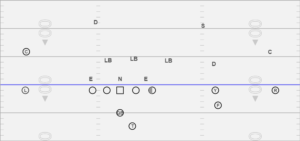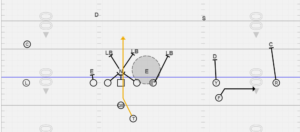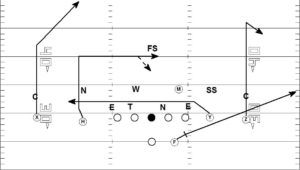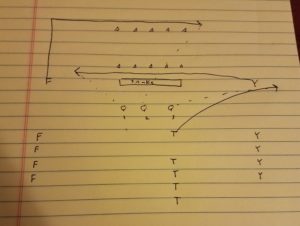Ah, the 3-3 Stack. A balanced defense that allows defensive coordinators the chance to stop the Spread Offense by bringing exotic stunts and blitzes.
It’s an offensive coordinator’s worst nightmare.
But should it be?
No, it shouldn’t.
That’s why I’m going to go over one of the ways we attack the 3-3 Stack using our inside zone play.

Yes I stole this formation from Baylor. Sue me.
When you go against the 3-3 Stack you need to get out of your normal 2 x 2 formation mindset. The 3-3 Stack is designed to go up against those formations. You are making the defenses job easier when you sit in a static, balanced formation.
We want to get into some form of 3 x 1. The above formation is one of my favorites. We call it Trio Rt Special. The ‘Special’ tag tells the F to line up behind the Y in a Stack alignment.
How does this formation cause problems for the defense? The defense is out numbered two to one by our stacked wide receivers.
“But Coach McKie,” you ask. “Won’t the defense just roll down the safety and go cover one when they see this formation?”
Nope.
Defensive coordinators are in love with Palm’s coverage the same way Spread coaches are in love with the Run Pass Options. They are going to stay in two high until their Lord Saban tells them it is okay to roll down against 3 x 1 formations.
But, defensive coaches aren’t completely stupid. They are still going to try to dictate who is going to keep the ball on the zone read. That’s why they will put their defensive ends in a 4i.
Now, the defense is forcing the quarterback to pull the ball since the ‘read’ key is slanting inside to take away the dive. This puts the Outside Linebacker as the quarterback player.
That’s okay though. Let the defensive coordinators think they’ve won this battle. It will make their tears that sweeter when we score a rushing touchdown on them.
How We Combat This Strategy
We have our backside tackle arc release to the Outside Linebacker that’s head up to outside of him and have the Quarterback read the 4i. (Note: You can either teach it this way or make it a call from the sideline.)

How do you like me now Defensive Coordinators?
Why do we do this instead of having our tackle wash down the 4i? Because our tackles aren’t that good at washing down 4is. So instead of banging my head against the wall and wailing to the football gods for cursing me with offensive linemen that can’t wash anyone down, I instead teach them to arc release to the second level and have our Quarterback read the 4i trying to make the play.
It’s a win-win situation for the tackle and myself. He doesn’t have to hear me screaming at him during practice, and I don’t have to get a headache.
Blocking Scheme
Left Tackle: You have someone head up to outside of you so you will base block that man.
Left Guard: You don’t have a defender in your play side B-Gap, nor do you have a defender in your back side A-gap. So you will help the center double team the nose, while having your eyes on the Front Side Linebacker. Once the Front Side Linebacker triggers towards the line of scrimmage then you will come off the double team and block him.
Center: You are covered. Therefore you will block the nose guard. Easy.
Right Guard: You do not have anyone in your front side A-Gap. You do have a B-gap defender in the back side B-Gap, BUT you know the center is covered. So you will double the nose with your eyes on the Back Side Linebacker/Middle Linebacker. When the Back Side Linebacker/Middle Linebacker triggers towards the line of scrimmage then you will come off the double team and block him.
Right Tackle: You have a 4i and you know that the center is covered. So you will arc release - meaning you will not block the guy in the play side B-Gap - and immediately block the linebacker that is head up to outside of you.
Quarterback Reads
You are reading the B-Gap defender. If the B-Gap defender runs straight at you then you will hand the ball off to the Running Back. If the B-Gap defender flies towards the Running Back then you will pull the ball and chase the butt of the Right Tackle.
If the Outside Linebacker lined up over the Y comes to tackle you then you will flip the ball out to the F receiver running the key screen. If the Outside Linebacker lined up over the Y chases the key screen then you will turn up and score.
Wide Receivers
You will be running our normal quick screen.
The R recevier will block the corner.
The Y receiver will block the Outside Linebacker over him. If the Outside Linebacker chases the Quarterback then you will turn up and block the first different colored jersey you see.
The F receiver will take one step forward and then back pedal. You are looking for the ball. If you get it then you will put your foot in the ground and get North and South.
Running Back
Your steps are as followed: Open, Cross Over, Bang it behind the Center’s butt.
That’s the play.
You need to realize that this is one of the two running plays we have, before you tell me that it isn’t an easy play. I am a firm believer of Less is More.
So there you have it. That is one of the ways we attack the 3-3 Stack using our Inside zone. If you do anything different then please leave a comment below. I love hearing from ya’ll.
Also, please Check out my FREE One Back Power eBook if you haven’t already. You can sign up on the side of my webpage.
And until next week, let’s Master the Spread, Score Points, and Have Fun!



